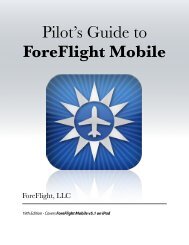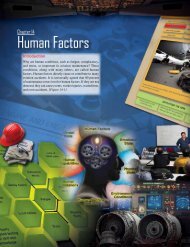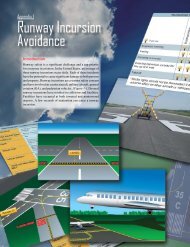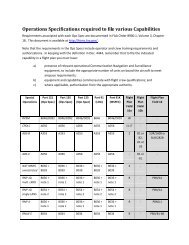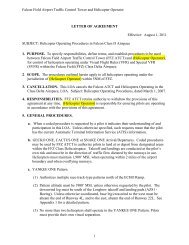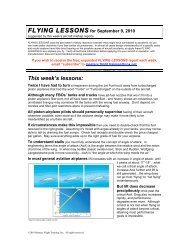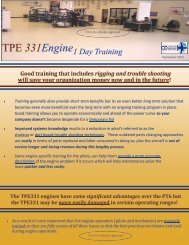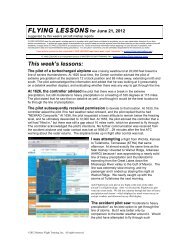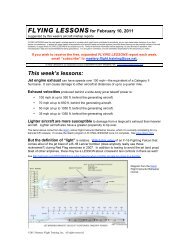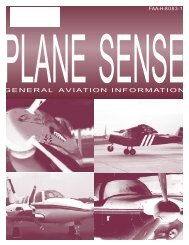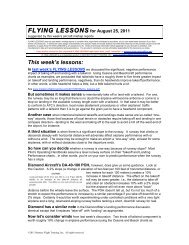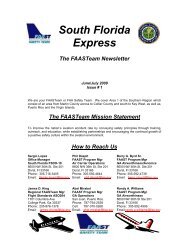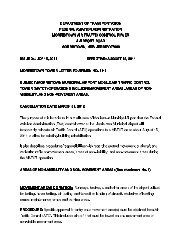Advisory Circular - FAASafety.gov
Advisory Circular - FAASafety.gov
Advisory Circular - FAASafety.gov
Create successful ePaper yourself
Turn your PDF publications into a flip-book with our unique Google optimized e-Paper software.
U.S. Department of Transport at ion<br />
Federal Aviation Administration<br />
<strong>Advisory</strong><br />
<strong>Circular</strong><br />
Subject: PILOT PROFICIENCY AWARD PROGRAM<br />
Date : 4/26/96 AC No: 61-91H<br />
Initiated by AFS-810<br />
Change:<br />
1. PURPOSE. This advisory circular (AC) describes the<br />
Federal Aviation Administration's (FAA) Pilot Proficiency<br />
Award Program and outlines the eligibility requirements for<br />
pilots to qualify for Phase I through Phase XX Pilot<br />
Proficiency Awards.<br />
2. OBJECTIVE. Regular proficiency training is essential to<br />
the safety of all pilots and their passengers. The objective<br />
of the Pilot Proficiency Award Program is to provide pilots<br />
with the opportunity to establish and participate in a<br />
personal recurrent training program. Aviation safety is a<br />
cooperative effort of all members of the aviation<br />
community. The FAA encourages each pilot to establish a<br />
regular recurrent training program and invites pilots to<br />
participate in the Pilot Proficiency Award Program.<br />
3. CANCELLATION. AC 61-91G, Pilot Proficiency Award<br />
Program, dated 8/4/94, is canceled.<br />
4. WHO MAY PARTICIPATE. All pilots holding a<br />
recreational pilot certificate or higher and a current<br />
medical certificate, when required, may participate. In<br />
addition, uncertificated pilots of qualified ultralight vehicles<br />
under Title 14 of the Federal Code of Regulations (14<br />
CFR) part 103 may participate. Requests to participate in<br />
the program should be made to a certificated flight<br />
instructor, an appointed Aviation Safety Counselor (ASC),<br />
or the Safety Program Manager (SPM) in the local FAA<br />
Flight Standards District Office (FSDO).<br />
5. INCENTIVE AWARDS - PILOT WINGS AND<br />
CERTIFICATE. The Pilot Proficiency Award Program is<br />
now a 20-phase program. Upon completion of each of the<br />
first 10 phases, pilots become eligible to wear and are<br />
presented with a distinctive lapel or tie pin (wings) and a<br />
certificate of completion.<br />
Phase I wings are plain bronze tone. Phase II wings are<br />
silver tone with a star added. Phase III wings are gold tone<br />
with a star and wreath. Phase IV wings are gold tone and<br />
have a simulated ruby mounted in the shield. Phase V<br />
wings are gold tone with a rhinestone mounted in the<br />
shield. Phase VI wings are gold tone with a simulated<br />
sapphire mounted in the shield. Phases VII, VIII, and IX<br />
wings are gold tone with the appropriate Roman numeral<br />
displayed within the wreath. Phase X wings are bright gold<br />
tone with the Roman numeral X and shield located within<br />
a ring of 10 stars. No complimentary wings will be issued.<br />
Pilots, regardless of certificate type, ratings, or position,<br />
must earn the privilege of wearing the pilot proficiency<br />
wings. A pin and certificate will be awarded for Phases I<br />
through X. A certificate only will be awarded for Phases XI<br />
through XX.<br />
NOTE: Seaplane-rated pilots who specify<br />
"seawings" on their proficiency record/ wings<br />
application form and complete the<br />
requirements listed below for seaplanes and<br />
amphibians will receive a distinctive<br />
seawings pin.<br />
6. PARTICIPATION IN THE PILOT PROFICIENCY<br />
AWARD PROGRAM IN LIEU OF A FLIGHT REVIEW. A<br />
pilot need not accomplish the flight review requirements of<br />
14 CFR part 61, ~ 61.56 if, since the beginning of the 24th<br />
calendar month before the month in which that pilot acts<br />
as pilot in command, he or she has satisfactorily<br />
completed one or more phases of an FAA-sponsored Pilot<br />
Proficiency Award Program in an aircraft (reference<br />
61.56(1)).
AC 61-91H<br />
7. TRAINING REQUIREMENTS PHASES I THROUGH<br />
XX. Minimum requirements, which Include specific<br />
subjects and flight maneuvers, have been established for<br />
airplanes, seaplanes and amphibians, rotorcraft, gliders,<br />
lighter-than-air aircraft and uftralight. The required training<br />
profiles represent those phases of operation that have<br />
been identified by accident reports, as phases most likely<br />
to produce accidents. These training profiles are<br />
established for each category of aircraft. Pilots may select<br />
the category and class of aircraft or ultralight in which<br />
they wish to receive their flight training. All training must<br />
place special emphasis on safety of flight operations. All<br />
training requirements for each phase of the program must<br />
be completed within 12 months. After completing a phase<br />
of the program, pilots may begin working on the<br />
requirements of the succeeding phase at any time;<br />
however, 12 months must pass between the date of<br />
completion of it phase and application for tile award for the<br />
next phase.<br />
a. Airplanes.<br />
(1) One hour of flight training to include basic airplane<br />
control stalls, turns, and other maneuvers directed toward<br />
mastery of the airplane.<br />
(2) One hour of flight training to include approaches,<br />
takeoffs, and landings, including crosswind. soft field, and<br />
short field techniques.<br />
(3) One hour of instrument training in an airplane, FAAapproved<br />
aircraft simulator or training device.<br />
b. Seaplanes and Amphibians.<br />
(1) One hour of flight training in a seaplane or amphibian<br />
to include a demonstration by the applicant of a complete<br />
seaplane or amphibian passenger safety briefing, a weight<br />
and balance computation and interpretation for the actual<br />
flight, a review and evaluation of current and forecast<br />
weather, and on-the-water training in docking, beaching<br />
and anchoring, and maneuvering in confined areas.<br />
(2) One hour of flight training in a seaplane or amphibian<br />
to include landing area assessment, safe approaches and<br />
departures, takeoffs, and landings, including crosswind,<br />
rough water, and glassy water techniques. (Conditions<br />
may be simulated.)<br />
(3) One hour of flight training in a seaplane or amphibian<br />
to include power-on and power-off<br />
Page 2<br />
stalls in various configurations with minimum altitude loss,<br />
power-off emergency landings, step taxi, step turns, rapid<br />
decelerations from the step, and emergency procedures.<br />
In addition to the 1 hour of flight time (not included in the 1<br />
hour), there must be a discussion of stall avoidance and<br />
prevention techniques,<br />
c. Rotorcraft.<br />
NOTE: If the applicant is not qualified and<br />
current in accordance with 61.57 for<br />
instrument flight, 1 additional hour of basic<br />
instrument training with emphasis on partial<br />
panel approaches, inadvertent penetration<br />
into instrument meteorological conditions<br />
(180 turn), descent into visual meteorological<br />
conditions, and safe operations shall he<br />
accomplished in an airplane, seaplane, FAAapproved<br />
aircraft simulator, or training<br />
device for each odd-numbered award phase<br />
(Phase 1, III, V, etc.).<br />
(1) One hour of ground training to include use of the<br />
rotorcraft flight manual to, determine operating limitations,<br />
weight rind balance computations, performance data,<br />
aircraft servicing, use of optional equipment, and standard<br />
emergency procedures.<br />
(2) One hour of flight training to include airport and traffic<br />
pattern operations, including departures from a hover<br />
(helicopter only), normal and crosswind approaches and<br />
landings, maximum performance takeoffs, and steep<br />
approaches.<br />
(3) One hour of flight training to include systems<br />
orientation, autorotative descents, power failure at a hover,<br />
settling-with-power, pinnacle/rooftop takeoffs and landings,<br />
and navigation procedures.<br />
d. Gliders.<br />
(1) One hour of ground training to include preflight<br />
operations. including installation of wings and tail<br />
surfaces, on-line inspection, use of glider operating<br />
limitations, weight and balance computations,<br />
performance data, and standard emergency procedures.<br />
(2) One hour or three flights to include launch<br />
procedures, proper position during tow, emergency<br />
procedures such as a slack line or tow rope failure, and<br />
tow release procedures.<br />
(3) One hour or three flights to include thermalling<br />
procedures, flight in close proximity to other aircraft,<br />
maneuvers at various performance
AC 61-91H<br />
speeds, demonstration of best lift over drag (L/D) and<br />
minimum sink, and precision approaches and landings.<br />
e. Lighter-Than-Air.<br />
(1) One hour of ground training to include fuel<br />
management, refueling, proper inflation procedures, review<br />
of the flight manual, and proper weather check.<br />
(2) One hour of flight training to include approaches,<br />
touch-and-go, level flight, rapid descent and level out, and<br />
simulated landing in a congested area.<br />
(3) One hour of flight training to include relighting the<br />
pilot light, simulated high wind/short field landings, and<br />
other simulated emergency situations.<br />
f. Ultralights. Pilot Proficiency Award Program training<br />
given in powered ultralight vehicles by United States<br />
Ultralight Association, Inc. (USUA)-approved flight<br />
instructors or other approved powered ultralight flight<br />
instructors will be accepted.<br />
(1) One hour of ground training on preflight operations to<br />
include operating limitations, weight and balance<br />
computations, performance data, vehicle servicing, use of<br />
optional equipment, and standard emergency equipment.<br />
(2) One hour of basic vehicle control, turns and other<br />
maneuvers directed towards mastery of the vehicle.<br />
(3) One hour of flight training to include airport and traffic<br />
pattern operations, including departures, normal and<br />
crosswind approaches and landings, maximum<br />
performance takeoffs, and steep approaches.<br />
g. Mountain Flying Course. Applicants who<br />
successfully complete an FAA-sponsored or FAA<br />
sanctioned mountain flying course, including ground and<br />
flight training, may substitute this course for the safety<br />
meeting required by subparagraph h when completing all<br />
other mountain flying requirements.<br />
(1) One hour of flight training to include basic airplane<br />
control, stalls, and other maneuvers with emphasis on the<br />
use and difference of performing these maneuvers in<br />
mountainous terrain and under high density altitude<br />
conditions. AC 61-91H<br />
(2) One hour of flight training to include approaches,<br />
takeoffs, and landings at or simulating mountain airports<br />
with high density altitudes.<br />
(3) One hour of ground training to include effects of high<br />
density altitude, mountain terrain, and mountain weather<br />
conditions.<br />
h. Safety Meetings.<br />
(1) All applicants must attend at least one<br />
FAA-sponsored or FAA-sanctioned aviation safety<br />
seminar or industry-conducted recurrent training program.<br />
(2) Attendance at an Aviation Safety Program aviation<br />
safety seminar must be verified in the pilot's logbook or<br />
other proficiency record. This verification must be signed<br />
by an FAA SPM, other FAA inspector, or an ASC involved<br />
in conducting the seminar.<br />
(3) Attendance at a physiological training course<br />
conducted under the FAA/U.S. Air Force or U.S. Navy<br />
training agreements at various military installations in the<br />
United States is also acceptable as a safety meeting. It is<br />
necessary to complete AC Form 3150-7, Physiological<br />
Training Application/ Agreement, to participate in<br />
physiological training. The form may be obtained from the<br />
SPM in the local FSDO or by a letter of request to:<br />
Mike Monroney Aeronautical Center<br />
Airman Education Programs, AAM-400<br />
P.O. Box 25082<br />
Oklahoma City, OK 73125<br />
Pilots who do not wish to participate in physiological<br />
training need not complete the form. Pilots completing a<br />
physiological training course will receive FAA Form 3150-<br />
1, Physiological Training. A completed FAA Form 3150-1<br />
must be submitted to the SPM for verification of course<br />
completion.<br />
i. Training Substitution. Completion of training program<br />
or a flight instructor refresher clinic conducted by various<br />
organizations such as flight schools, air carriers, or other<br />
training facilities may be substituted for the requirements<br />
of the Pilot Proficiency Award Program, if the minimums<br />
outlined in paragraphs 7a, b, c, d, e, f, and g are met.<br />
j. Aircraft Accidents and Enforcement Actions.<br />
Involvement in an aircraft or ultralight vehicle accident<br />
and/or a pending or completed enforcement action will not<br />
preclude participation in the Pilot
Page 3<br />
Page 4<br />
AC 61-91H<br />
Proficiency Award Program. However, a pilot who has<br />
been involved in an accident or enforcement action should<br />
request that the flight instructor place special emphasis<br />
on the causal factors of the accident or enforcement<br />
action during pilot proficiency training. The instructor<br />
should focus the training on educating the pilot in ways to<br />
preclude future accidents or enforcement actions.<br />
8. PILOT PROFICIENCY AWARDS EARNED BY FLIGHT<br />
INSTRUCTORS.<br />
a. Phase I Through III Requirements. A certificated<br />
flight instructor, USUA-approved flight instructor, or other<br />
approved powered ultralight flight instructor may earn<br />
Phases I through III wings by providing the required<br />
instruction for completion of a phase of the Pilot<br />
Proficiency Award Program to three pilots (a minimum of<br />
9 hours of instruction). To qualify for a Phase I wings<br />
award, an instructor must document the completion of the<br />
training he or she has given to at least three pilots and<br />
attend or participate in an aviation safety seminar or clinic.<br />
The instruction given must be in accordance with<br />
paragraphs 7a, b, c, or d, e, f, or g, as appropriate. The<br />
completion of the required instruction for three additional<br />
pilots and attendance or participation in an additional<br />
safety seminar or clinic is required to earn a Phase II<br />
award. An instructor may repeat the requirements<br />
stipulated for a Phase II award to earn a Phase III award.<br />
b. Phase IV Through XX Requirements. Twelve<br />
months after the date of meeting the requirements for the<br />
Phase III award, a certificated flight instructor, USUAapproved<br />
flight instructor, or other approved powered<br />
ultralight flight instructor may apply for the Phase IV<br />
award. Phases IV through XX award wings and/or<br />
certificate may be earned by the successful completion of<br />
an evaluation or proficiency flight with a designated flight<br />
instructor examiner or an FAA operations inspector and<br />
by attending or participating in an aviation safety seminar<br />
or clinic. USUA-approved or other approved powered<br />
ultralight vehicle flight instructors may receive their<br />
evaluations or proficiency flights with a USUA-approved<br />
advanced flight instructor. Twelve months must pass<br />
between the date of completion of each phase and<br />
application for the award for the next phase.<br />
c. Safety Meetings. Flight instructors and powered<br />
ultralight vehicle flight instructors must also attend or<br />
participate in at least one FAA-sponsored or FAAsanctioned<br />
aviation safety seminar, attend an FAAapproved<br />
Flight Instructor Refresher Clinic, or complete a<br />
physiological training course as specified in paragraph<br />
7h(3) to meet the requirements for each phase of the<br />
awards. Attendance must also be verified in the flight<br />
instructor's logbook or other proficiency record. This<br />
verification must be signed by an SPM, other FAA<br />
inspector, or any ASC involved in conducting the above<br />
programs.<br />
9. AWARDING OF THE PILOT PROFICIENCY WINGS<br />
AND CERTIFICATE.<br />
a. Endorsement Verification. As pilots complete each<br />
step of training outlined in paragraphs 7 or 8, whichever is<br />
appropriate, their logbooks or other proficiency records<br />
must be endorsed by the persons who gave the<br />
instruction. That endorsement should read substantively<br />
as follows:<br />
Mr./Ms._________________, holder of pilot<br />
certificate no.___________, has satisfactorily<br />
completed the training requirements outlined in<br />
<strong>Advisory</strong> <strong>Circular</strong> 61-9111, paragraphs 7a, b, c, d,<br />
e, f, or g (state which)<br />
/s/ (date) M. Smith, 385652472CFI or<br />
/s/ (date) M. Smith, USUA Ultralight Instructor (or<br />
other approved instructor)123454<br />
Note: In the case of ultralights, no certificate number<br />
is required.<br />
b. Award of Pilot Proficiency Wings and Certificate.<br />
The Pilot Proficiency Award certificate and the appropriate<br />
wings will be awarded after the pilot's logbook or other<br />
proficiency record (such as a properly documented "wings<br />
card") is presented to the SPM for verification of<br />
completion of training as stipulated in this AC.<br />
William J. White<br />
Deputy Director, Flight Standards Service




